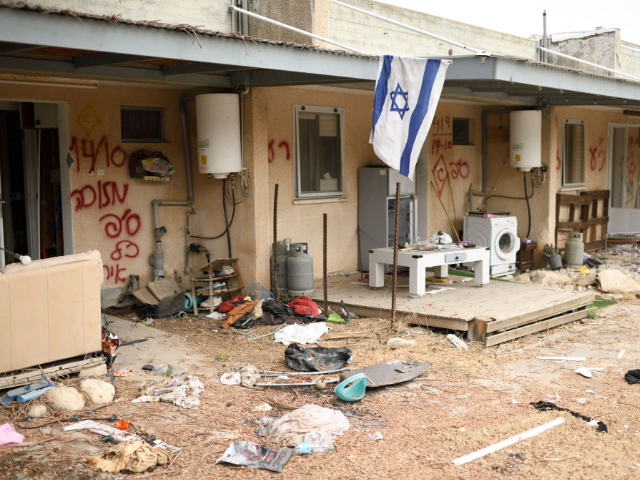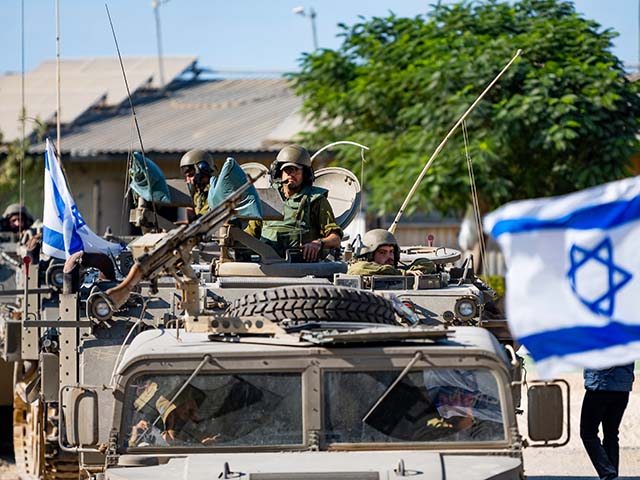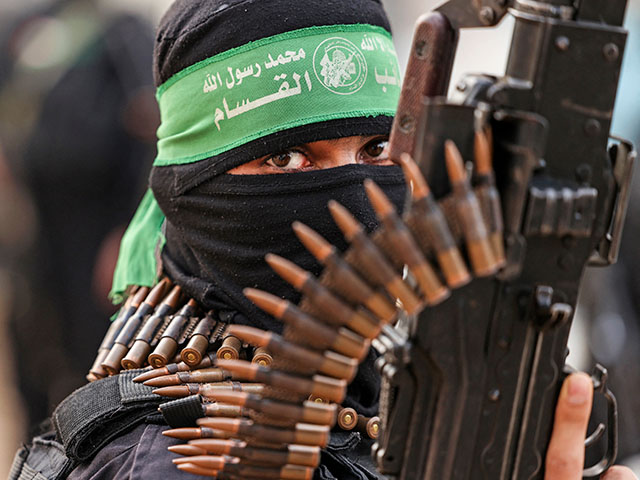October 7 was not a mere terror attack but a “full-scale invasion” of Israel by an enemy state, according to retired United States Army Major and urban and subterranean warfare expert John Spencer, who warned of setting a dangerous precedent if Hamas is allowed to survive, while slamming countries who are “playing [right] into Hamas’s strategy” by attempting to halt Israel’s operations in Gaza aimed at destroying the terror group’s capabilities.
In an exclusive interview with Breitbart News, Spencer, a world-renowned expert on urban combat who serves as chair of urban warfare studies at the Modern War Institute (MWI) at West Point and who recently returned from a visit to Israel’s front lines, offered his perspective on the current conflict.
October 7: A “Full-Scale Invasion”
“It’s been a big part of my research,” he began, emphasizing the importance of understanding the ground realities in the Jewish state. Contrary to popular narratives, he described the events of October 7 not as mere terrorist attacks but as a “full-scale invasion,” involving division-sized military forces from Gaza.
“If you count the three waves of terrorists or civilians who turned themselves into combatants in the invasion, it was over 4,000 Gazans from Hamas, Palestinian Islamic Jihad, and others,” he explained, underlining the scale and preparedness of the attackers.

The aftermath of Hamas attack on Kibbutz Kfar Aza, one of the hardest-hit communities in the October 7 onslaught by Hamas, on October 27, 2023. (Gili Yaari/NurPhoto via Getty Images)
“They had a plan,” he added, noting that “over four thousand rockets were launched” during the invasion.
While a terrorist “raid” would normally see a strike and a “planned withdrawal,” he explained, the October 7 attackers “had much greater plans of reaching other military bases, Tel Aviv, [and even] Jerusalem” and remaining in those areas.
Though the plan’s extent was “halted, through the police and the local rapid-response teams,” Spencer insisted that “by every definition, it was a full-scale invasion of Israel by another country with a plan to cause massive damage.”
Debunking the notion of incidental harm, Spencer, a founding member of the International Working Group on Subterranean Warfare, highlighted the invasion’s calculated brutality, especially towards civilians.
“The biggest thing that I think I’ve learned, not just from watching the video of the Hamas footage, but from walking the ground, is how methodically planned out the attack of civilians was,” he said. “They breached the border wall at 22 different locations and there were 20 different attack sites.”
“So once they crossed the border, they moved to these selected areas and then began systematically sealing them off and killing civilians,” he added.
According to Spencer, the strategic choice to inflict mass civilian casualties speaks volumes of the attackers’ intentions, noting that Hamas “Meticulously and precisely targeted urban areas, with the intention of killing as many civilians as possible.”
“It wasn’t incidental as some people, like disinformation agents, have been trying to push out,” he said, adding that Hamas “prevented support from arriving to the civilians so they could prolong methodically killing them house-to-house.”
“That was a big part of learning about what happened,” he explained.
“The World is Playing into Hamas’s Strategy”
While many people talk about Israel’s strategy, Spencer noted, “what they don’t talk about is the Hamas strategy.”
While Hamas’s strategy is one of information warfare, the essence of war, as Spencer puts it, is “a contest of wills,” where the ultimate goal extends beyond physical conquest to encompass political and psychological dominance.
“War is this contest of wills between not just the military fighting wars, but their politicians on both sides, since it is about achieving political goals, and the populations that support those politicians and governments and how much,” he said.
Emphasizing the importance of heeding the explicit statements and intentions of the Islamist terror group, Spencer called attention to Hamas’s overarching plan.
“So Hamas built this grand strategy to destroy Israel, and to kill all Jews,” he states, noting that “it’s unique that we have a terror group that nobody is willing to actually listen to, even when they say, ‘this is [exactly] what I was trying to do; this is my plan.’”
“They’ve [explicitly] said since the war began, ‘I will repeat October 7,’ ‘That was just a warm- up,’ and ‘I want to do it over and over again to achieve my grand strategy,’” he added.
Hamas’s approach, Spencer explains, transcends conventional warfare tactics, aiming to exploit the international community’s response to civilian casualties, generate global condemnation of Israel, hamstring the IDF’s operations, and protect Hamas’s military capabilities under the guise of civilian safety.
“Their strategy for the war is to get as many civilians killed as possible to martyr them all. So that the world forces the IDF to stop,” he explained.
A critical component of Hamas’s military infrastructure is its tunnel network, which, according to Spencer, serves a dual purpose: to facilitate attacks on Israeli civilians and to prolong the conflict, betting on international pressure to limit IDF operations.

IDF soldiers ride in armored personnel carriers on October 17, 2023 in Be’eri, Israel. (Alexi J. Rosenfeld/Getty Images)
“Their entire tunnel network underneath every civilian facility is about [buying] time and the international will for how long they will let the IDF continue because they want the IDF finished,” he articulated, exposing the calculated use of civilian areas for military advantage.
Criticizing countries insisting Israel stop its operations, Spencer suggested the global reaction to the conflict plays into Hamas’s hands.
“The world is playing into Hamas’s strategy!” he exclaimed, pointing out that international demands for a ceasefire align with Hamas’s objectives.
According to Spencer, the world “gives Hamas hope” that their strategy is working.
“Their strategy of using human shields, of causing as much destruction as possible, of convincing the world that it’s not possible to defeat them and that the war should just stop, is working 100 percent, despite the actual reality of what the unprecedented successes of the IDF have actually achieved on the ground,” he said.
“The fastest way to bring [the war] to an end is to destroy the remaining Hamas battalions,” he added.
However, he noted, despite Israel’s efforts to dismantle Hamas’s military capabilities and mitigate civilian harm, Hamas views any form of survival as a victory, leveraging the movement of civilians and hostages to garner international sympathy and condemnation against Israel:
Despite the immense success that Israel has had in achieving their strategy, which is to remove Hamas’ ability to use the tunnels to buy time; to remove Hamas’ ability to get civilians killed away from them — despite the [false] narrative — to take away their military capabilities; and to destroy their military forces and capability, the Hamas strategy is still working, leading to the fact that they are overtly hopeful they will survive because that’s all it takes for Hamas to win.
As for what it takes for Israel to achieve victory, Spencer listed the return of the hostages and the destruction of Hamas and all its military capabilities in order to guarantee a “secure Israel border.”
“We can define that, and, by definition, Israel is achieving that,” he said.
Watch: IDF Reveals Surveillance Footage of Hamas Leader in Gaza Yahya Sinwar Fleeing in Tunnel
Manipulation of Civilian Casualty Figures
Turning to the political landscape, Spencer criticizes the manipulation of casualty figures and media narratives.
“You don’t play politics with people’s lives,” he asserts, challenging the reliability of reported casualty numbers.
“Even the use of Hamas’s casualty numbers to infer how the war is going is not accurate,” he explains. “There have not been 31,000–32,000 civilian deaths in Gaza. It accounts for zero Hamas combatant deaths.”
In reality, he noted, the IDF “has been successful at bringing the casualty count of civilians in urban combat to a historic low.”
“I’ve never seen a war, in the history of war, where they had a daily running civilian casualty count down to the single digit — and it was only the enemy providing that number,” he said.
The Day After
Reflecting on the future, Spencer stressed the importance of a strategic vision for the post-conflict scenario.
“Israel not only has to have a day after plan,” he acknowledged, pointing to the necessity of learning from past conflicts to avoid repeating mistakes, “but there are a lot of lessons from the US’s mistakes in Iraq and Afghanistan that we had to learn over the years, that don’t have to be relearnt — and I see Israel, in discussions of what the day after will look like, learning from those lessons.”
However, he noted, Hamas is not a “counterinsurgency” until their defeat.
“All these post conflict models and frameworks, counterterrorism, counterinsurgency, creating a new security environment, whether it’s localized tribal leaders, establishing new governance, all this happens after you destroy Hamas, and only after destroying Hamas,” he said.
“But yes, you have a day after — the day after Hamas is destroyed,” he added.
Spencer then warned that as long as Hamas is left in power “it won’t matter what you try to do, even in northern Gaza.”
“Hamas is still the governing authority of Gaza; it’s still the military power, even when it’s pushed on the ground in other areas,” he said, noting that “there are many fundamental principles of keeping an organization like Hamas from reappearing that have to be put into place.”

A member of Ezzedine al-Qassam Brigades, military wing of the Palestinian Hamas movement, takes part in a parade in Gaza City on November 14, 2021. (MAHMUD HAMS/AFP via Getty Images)
“What that looks like is up to Israel and other partners,” he concluded, noting that “it’s not just an Israel problem.”
In January, Spencer slammed Hamas’s use of “human sacrifice” tactics and warned that if Israel did not completely dismantle the terror organization then “massive genocidal attacks” and the taking of civilian hostages would be replicated by terrorists across the globe.
In November, he described the mission being carried out by the IDF as “very successful,” while deeming Hamas an “existential threat” whose strategy is to “create their own civilians’ deaths and get the world to react,” in order to prevent the IDF from eliminating their military capabilities — “and it is working.”
Joshua Klein is a reporter for Breitbart News. Email him at jklein@breitbart.com. Follow him on Twitter @JoshuaKlein.

COMMENTS
Please let us know if you're having issues with commenting.